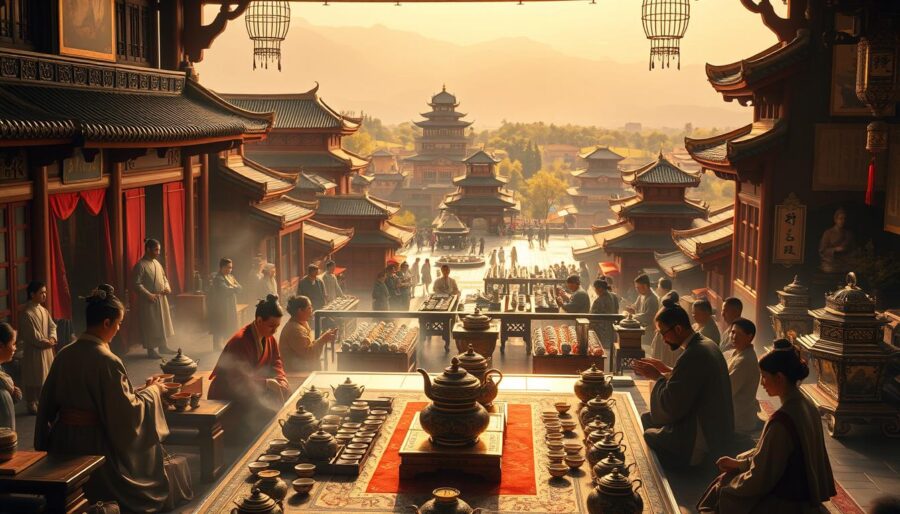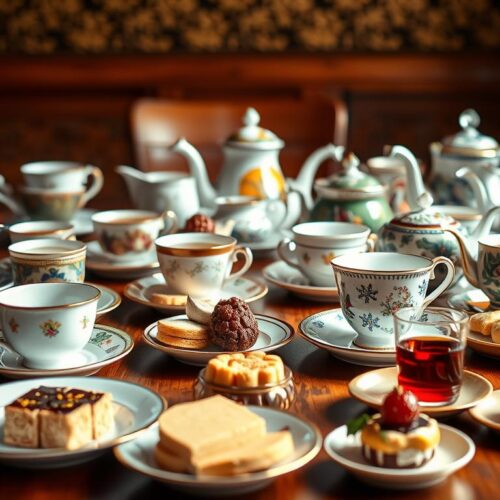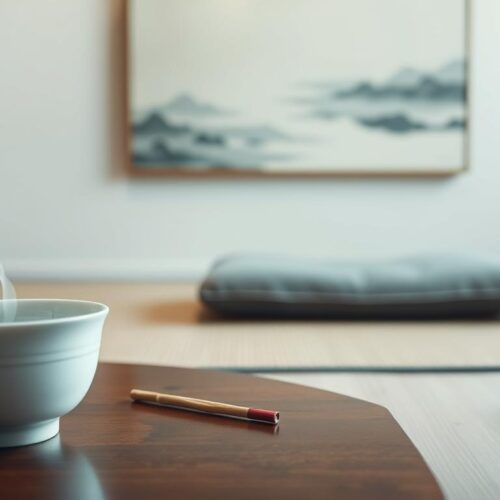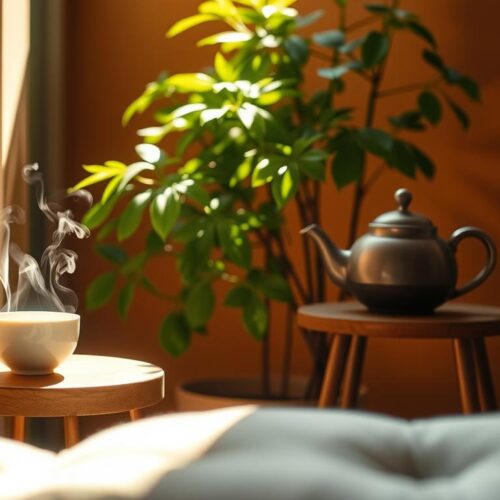The tea ceremony is more than just drinking a warm drink. It’s part of a deep cultural history that has grown over centuries. To learn about the tea ceremony’s history, we need to look back at China’s history. This includes the Tang, Song, Ming, and Qing dynasties. Each period added something special to the tea ceremony. This made it what it is today. In this journey, we will see how tea rituals have changed. And how they still touch people’s hearts worldwide.
Introduction to the Tea Ceremony
The tea ceremony is a door to the vast world of tea culture. It’s more than making and drinking tea. It includes appreciation of beauty, self-discipline, and socializing. In China and Japan, it’s an art that brings people together, focusing on the here and now.
Tea is not just about taste and smell. It carries the weight of traditions and beliefs. Joining a tea ceremony helps you stop and live in the moment. Every action, from choosing tools to pouring tea, is done carefully. This shows how something simple can also be deep and complex.
Learning about the tea ceremony opens your eyes to its importance in bringing people together. It teaches us about thoughtful living. Find out how tea culture helps us connect and makes sharing tea a special experience.
Historical Origins of the Tea Ceremony
The story of the tea ceremony starts with Shennong Emperor. He is believed to have found tea in 2737 BCE. This discovery led to the tea’s cultural journey. Over time, tea changed from being a health drink to a key cultural element during Chinese dynasties.
In the Tang dynasty, tea’s role in society became more defined. The publication of “The Classic of Tea” by Lu Yu set the stage for today’s tea practices. It taught the right ways to prepare tea and the necessary tools, creating rituals that we still follow. The art of tea was growing, showing its importance in culture and society.
The Song dynasty took tea traditions further, making it a valued tradition across China. Tea and art blended, making tea central in social events. The customs of tea drinking became firm, building a lasting tradition that mirrors wider cultural values.
The Rituals and Symbols
The rituals of tea ceremony are deeply meaningful. They go beyond making tea. Every action shows respect, harmony, and brings people together. The ceremony starts with carefully measuring tea leaves. Each leaf is important to the ritual.
Warming up the water is also key. It teaches patience and mindfulness. It’s not just about getting the water hot. It makes us think and feel the moment. When the tea is served, it’s about kindness and welcoming, making the experience special for everyone there.
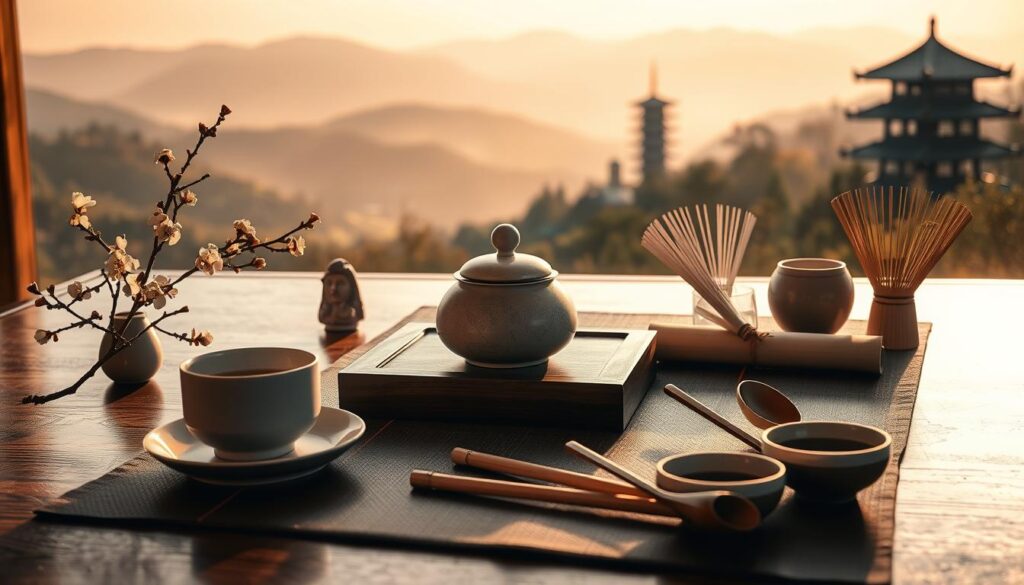
Every tool in the tea ceremony has its own story. They reflect the values and art of their origins. The teapot’s elegance, the cups’ beauty, and the tea choice add layers of meaning. Knowing this makes the tea ceremony more special.
| Ritual | Symbolism |
|---|---|
| Measuring Tea Leaves | Precision and care in crafting the perfect brew |
| Heating Water | Patience and mindfulness in preparation |
| Serving Tea | Hospitality and sharing among participants |
| Utensil Selection | Reflection of cultural values and aesthetics |
Joining in the tea ceremony rituals connects you to history. It helps you understand important cultural practices. This experience can grow your appreciation. It can also bring peace and mindfulness into your life.
Regional Variations
Tea traditions differ greatly across regions, showing the wide variety in tea culture. In China, ceremonies like Jian Cha, Dian Cha, and Pao Cha highlight different aspects. Jian Cha focuses on the brewing method, bringing out the tea’s scent and taste.
Dian Cha values how tea is presented, showcasing its beauty. Pao Cha, meanwhile, is about community and sharing the tea together.
In Japan, Zen Buddhism influences the tea ceremony, where being mindful and simple is key. Every action is done with intent, showing respect for the tea and setting. This meld of spirituality and beauty sets it apart from other tea traditions.
Looking into these tea customs reveals how local traditions and values influence them. From the calm of Japanese tea houses to the lively Chinese ceremonies, each method has its own meaning. This helps us understand the vast diversity of tea culture.
The Role of Tea in Society
Tea means much more than just something to drink. It helps people connect across different cultures. Tea brings warmth and friendship, especially during special times and gatherings.
In the Tang dynasty, tea became more than a health drink. It became essential among scholars for social gatherings. It helped boost friendships, spark talks, and connect different cultures.
Tea ceremonies show how tea brings people closer. These events turn simple meet-ups into deep conversations. Here, through the art of making tea, people find a sense of community and value each other more.
Modern Adaptations of the Tea Ceremony
The way we experience tea ceremonies is changing. As society moves forward, we’re seeing tea ceremonies become more open and easy for everyone to enjoy. Today, they mix old traditions with new twists, making them interesting for folks of all ages.
There are new styles in how tea is made and shown. For example, simpler tea ware designs highlight beauty in simplicity. This matches well with being mindful and living on purpose. These changes help us find joy in the simple act of drinking tea.
Also, social media has had a big impact on tea ceremonies. People share cool brewing techniques, new tastes, and pretty tea setups online. This builds a community that celebrates tea together. It shows that the tradition of tea ceremonies is still growing and reaching more people.
In the end, these new twists on tea ceremonies mix the old with the new in an interesting way. You can see these changes for yourself by visiting local tea shops or going to workshops. This is a chance to dive into the latest trends in tea culture.
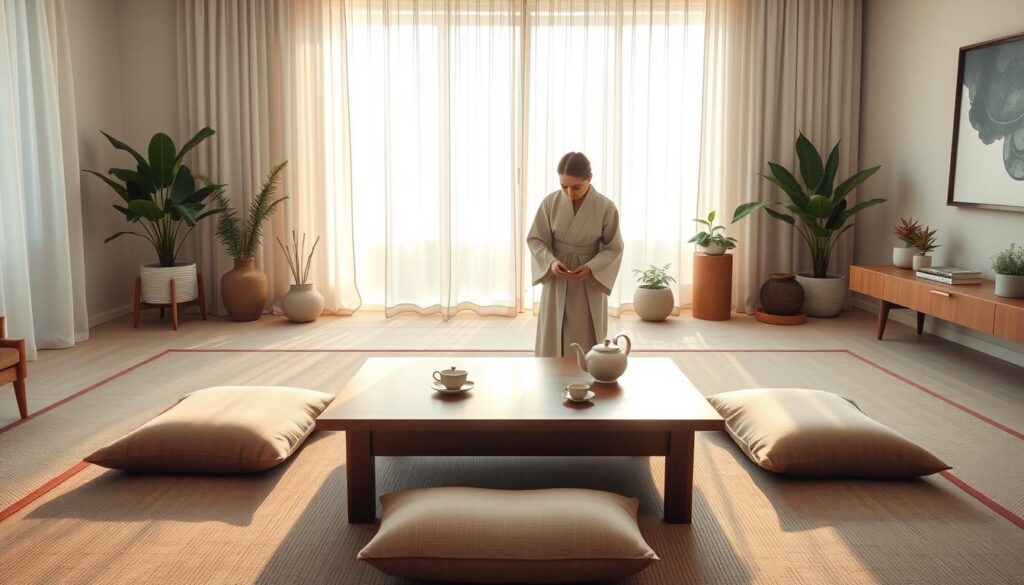
Health Benefits of Tea
Tea has been loved for its medicinal qualities across various cultures. People today still value tea for its health perks. Drinking different kinds helps nourish our bodies and improve our well-being.
Many teas are full of antioxidants, helping to ease oxidative stress. Green tea, for instance, is loaded with catechins, boosting mental focus and brain power. Meanwhile, black tea helps make your heart stronger by bettering cholesterol levels.
Tea does more than just help our bodies. It also brings peace and mindfulness to many. The act of making and enjoying tea gives us a break, helping our minds relax. This shows tea’s power to heal us, not just physically, but mentally and emotionally, too.
Tea’s healing qualities make it treasured worldwide as a healthy drink and a way to feel better. By including it in our daily routines, we can make our lives richer. Tea remains a beloved part of daily living.
The Future of the Tea Ceremony
Tea traditions around the world are changing, hinting at an exciting future for tea ceremonies. The growing global interest in tea brings both challenges and chances for growth. It’s important to know these changes as tea culture changes for today’s tastes.
The spotlight is on being eco-friendly in tea culture’s future. More folks care about the planet, so they want tea grown in ways that don’t harm it. Tea makers are turning to organic methods and fair trade, making sure tea ceremonies stay valuable but also fit modern beliefs.
Also, people want real experiences. The tea ceremony’s future might mix new ideas with old traditions. Finding a good mix of new and traditional will draw different people, making tea more enjoyable and deep.
- Emphasis on sustainable sourcing
- Integration of modern technology in tea-making
- Focus on cultural education and awareness
- Personalization of tea experiences
Change in tea traditions is coming. As cultures mix, the tea ceremony will show a blend of influences but keep its heart. It’s key for fans and experts to go along with this change, making sure tea stays loved by future generations.
Conclusion: The Enduring Legacy of Tea
The legacy of tea stretches back centuries. It connects different cultures and gives us a shared experience. This goes beyond just drinking tea. Tea has grown into a deep way to express culture. Every sip reminds us of tea’s rich history, linking past and present.
Tea’s lasting culture invites us to join in rituals that mix uniqueness with tradition. You might enjoy a formal tea event or a relaxed meet-up with friends. Either way, the spirit of a tea ceremony is there. It celebrates not just the drink, but also the connections and moments it creates. These rituals show tea’s role in history, not just as a beverage but as a cultural pillar.
Thinking about tea’s role today, we see how it reflects values like mindfulness and harmony. Tea’s legacy inspires us. It shows us the universal human experience that goes beyond place and time. It brings us together, sharing warmth and friendship over a simple cup of tea.

